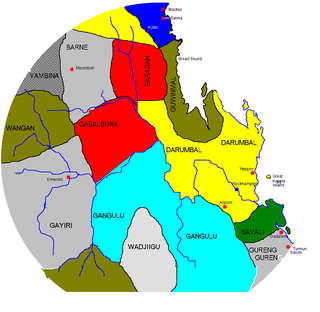| Minkin | |
|---|---|
| Region | Queensland, Australia |
| Ethnicity | Mingin people |
| Extinct | (date missing) |
Macro-Pama–Nyungan
| |
| Language codes | |
| ISO 639-3 | xxm |
| Glottolog | mink1237 [1] |
| AIATSIS [2] | G26 |
Minkin is an extinct Australian Aboriginal language, perhaps a language isolate, of northern Australia. It was spoken by the Mingin people in the area around Burketown, on the southern coast of the Gulf of Carpentaria, in an area that contains the headwaters of the Leichhardt River. [3]

An extinct language is a language that no longer has any speakers, especially if the language has no living descendants. In contrast, a dead language is "one that is no longer the native language of any community", even if it is still in use, like Latin. Languages that currently have living native speakers are sometimes called modern languages to contrast them with dead languages, especially in educational contexts.

The Australian Aboriginal languages consist of around 290–363 languages belonging to an estimated 28 language families and isolates, spoken by Aboriginal Australians of mainland Australia and a few nearby islands. The relationships between these languages are not clear at present. Despite this uncertainty, the Indigenous Australian languages are collectively covered by the technical term "Australian languages", or the "Australian family".
A language isolate, in the absolute sense, is a natural language with no demonstrable genealogical relationship with other languages, one that has not been demonstrated to descend from an ancestor common with any other language. Language isolates are in effect language families consisting of a single language. Commonly cited examples include Ainu, Basque, Korean, Sumerian, Elamite, and Vedda, though in each case a minority of linguists claim to have demonstrated a relationship with other languages.
The classification of Minkin is uncertain, primarily due to a lack of data. It has been suggested that it may have been related to the Yiwaidjan or Tankic language families. Evans (1990) believes it has been demonstrated to be a Tankic language, more distant than the others are to each other; this is accepted in Bowern (2011). [4]

A language family is a group of languages related through descent from a common ancestral language or parental language, called the proto-language of that family. The term "family" reflects the tree model of language origination in historical linguistics, which makes use of a metaphor comparing languages to people in a biological family tree, or in a subsequent modification, to species in a phylogenetic tree of evolutionary taxonomy. Linguists therefore describe the daughter languages within a language family as being genetically related.








